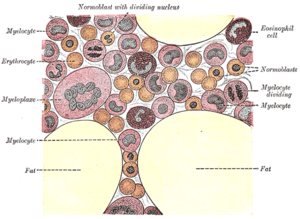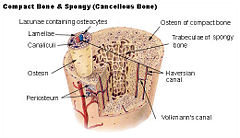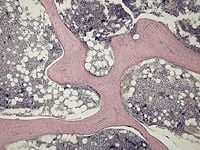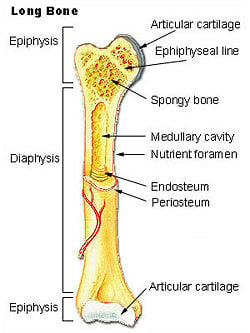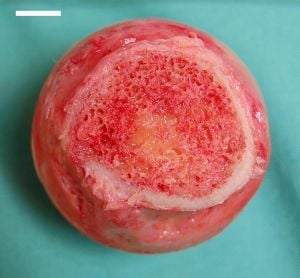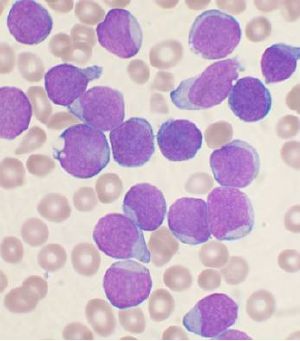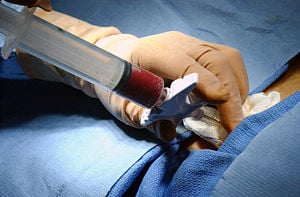Bone marrow
Bone marrow is the soft, flexible, vascular tissue tissue found in the hollow interior cavities and cancellous bone spaces of many vertebrate bones and the source of erythrocytes (red blood cells) and leukocytes (white blood cells) and a storage area for fat.
There are two main types of bone marrow. Red bone marrow is the center of production of all blood cells except some types of lymphocytes. Yellow bone marrow stores fats.
children only red marrow
fat storage
all but one kind of leukocyte
In adult humans, bone marrow constitutes about four percent of total body weight, or approximately 2.6 kilograms (5.7 pounds).
spongy
Overview
.
Bones are semi-rigid, porous, mineralized organs, consisting of cells in a hard matrix, that form part of the endoskeleton of vertebrates. Although externally bones may appear to be simple structures, in reality they are composed of living bone tissue interlaced with blood vessels, nerve fibers, and so forth.
Bone is not a uniformly solid material, but rather has some spaces between its hard components. The hard outer layer of bones is called compact bone tissue due to its minimal gaps or spaces. Filling the interior of the organ is the hole-filled spongy bone tissue (also called cancellous bone or trabecular bone), which is comprised of a network of flat or needle-shaped trabeculae, which makes the overall organ lighter and allows room for blood vessels and bone marrow. Spongy bone accounts for about 20 percent of total bone mass in humans, but has nearly ten times the surface area of compact bone. Cancellous bone is a type of osseous tissue with a low density and strength but very high surface area, that fills the inner cavity of long bones. The external layer of cancellous bone contains red bone marrow where the production of blood cellular components takes place. Cancellous bone is also where most of the arteries and veins of bone organs are found.
The bone marrow is located within the medullary cavity of long bones and the interstices of cancellous bone. Bone marrow is involved in the formation of both erythrocytes (red blood cells) and some leukocytes (white blood cells). The main categories of leukocytes are granulocytes (neutrophils, basophils, eosinophils), lymphocytes (B cells, T cells, natural killer cells), and monocytes (including macrophages). All of these types are produced and derived from a pluripotent cell—a cell that has the potential to differentiate into a variety of cells—in the bone marrow known as a hematopoietic stem cell. Mammalian stem cells differentiate into several kinds of blood cells within the bone marrow (Abbas and Lichtman 2003). This process is called hematopoiesis. However, not all leukocytes mature in the bone marrow. There are two main types of lymphocytes, T cells and B cells. While B cells remain in the bone marrow to mature, T cells migrate to and mature in a distinct organ called the thymus.
There is biologic compartmentalization in the bone marrow, in that certain cell types tend to aggregate in specific areas. For instance, erythrocytes, macrophages, and their precursors tend to gather around blood vessels, while granulocytes gather at the borders of the bone marrow.
Marrow types
There are two types of bone marrow: red marrow (consisting mainly of myeloid tissue) and yellow marrow (consisting mainly of fat cells). Red blood cells, platelets, and most white blood cells arise in red marrow; some white blood cells develop in yellow marrow. Both types of bone marrow contain numerous blood vessels and capillaries.
At birth, all bone marrow in children is red. With age, more and more of it is converted to the yellow type.
Red marrow is found mainly in the flat bones, such as the hip bone, breast bone, skull, ribs, vertebrae and shoulder blades, and in the cancellous ("spongy") material at the proximal ends of the long bones femur and humerus. Yellow marrow is found in the hollow interior of the middle portion of long bones.
In cases of severe blood loss, the body can convert yellow marrow back to red marrow in order to increase blood cell production.
Stroma
The stroma of the bone marrow is all tissue that is not directly involved in the primary function of hematopoiesis. The yellow bone marrow belongs here, and makes the majority of the bone marrow stroma, in addition to stromal cells located in the red bone marrow.
Still, the stroma is indirectly involved in hematopoiesis, since it provides the hematopoietic microenvironment that facilitates hematopoiesis by the parenchymal cells. For instance, they generate colony stimulating factors, affecting hematopoiesis.
Cells that constitute the bone marrow stroma are:
- fibroblasts (reticular connective tissue)
- macrophages
- adipocytes
- osteoblasts
- blood vessels (sinusoid)
Macrophages contribute especially to red blood cell production. They deliver iron for hemoglobin-production.
The blood vessels constitute a barrier, inhibiting immature blood cells from leaving the bone marrow. Only mature blood cells contain the membrane proteins required to attach to and pass the blood vessel endothelium. Hematopoietic stem cells may also cross the bone marrow barrier, and may thus be harvested from blood.
Stem cells
The bone marrow stroma contain mesenchymal stem cells (also called marrow stromal cells). These cells are multipotent stem cells that can differentiate into a variety of cell types. Cell types that MSCs have been shown to differentiate into in vitro or in vivo include osteoblasts, chondrocytes, myocytes, adipocytes, and, as described lately, beta-pancreatic islets cells. They can also transdifferentiate into neuronal cells.
Bone marrow contains three types of stem cells (Rubin and Strayer 2007):
- Hematopoietic stem cells give rise to the three classes of blood cells that are found in the circulation: white blood cells (leukocytes), red blood cells (erythrocytes), and platelets (thrombocytes).
- Mesenchymal stem cells are found arrayed around the central sinus in the bone marrow. They have the capability to differentiate into osteoblasts, chondrocytes, myocytes, and many other types of cells. They also function as "gatekeeper" cells of the bone marrow.
- Endothelial stem cells
Diseases involving the bone marrow
The normal bone marrow architecture can be displaced by malignancies or infections such as tuberculosis, leading to a decrease in the production of blood cells and blood platelets. In addition, cancers of the hematologic progenitor cells in the bone marrow can arise; these are the leukemias.
To diagnose diseases involving the bone marrow, a bone marrow aspiration is sometimes performed. This typically involves using a hollow needle to acquire a sample of red bone marrow from the crest of the ilium under general or local anesthesia. The average number of cells in a leg bone is about 440,000,000,000.
Exposure to radiation or chemotherapy will kill many of the rapidly dividing cells of the bone marrow and will therefore result in a depressed immune system. Many of the symptoms of radiation sickness are due to damage to the bone marrow cells.
Examination
Bone marrow examination is the pathologic analysis of samples of bone marrow obtained by bone marrow biopsy and bone marrow aspiration. Bone marrow examination is used in the diagnosis of a number of conditions, including leukemia, multiple myeloma, anemia, and pancytopenia. The bone marrow produces the cellular elements of the blood, including platelets, red blood cells and white blood cells. While much information can be gleaned by testing the blood itself (drawn from a vein by phlebotomy), it is sometimes necessary to examine the source of the blood cells in the bone marrow to obtain more information on hematopoiesis; this is the role of bone marrow aspiration and biopsy.
Donation and transplantation of bone marrow
It is possible to take hematopoietic stem cells from one person and then infuse them into another person (Allogenic) or into the same person at a later time (Autologous). If donor and recipient are compatible, these infused cells will then travel to the bone marrow and initiate blood cell production.
Transplantation from one person to another is performed in severe cases of disease of the bone marrow. The patient's marrow is first killed off with drugs or radiation, and then the new stem cells are introduced.
Before radiation therapy or chemotherapy in cases of cancer, some of the patient's hematopoietic stem cells are sometimes harvested and later infused back when the therapy is finished to restore the immune system.
Harvesting
The stem cells are harvested directly from the red marrow in the crest of the ilium, usually under general anesthesia. Contrary to popular belief, it is a minimally invasive outpatient procedure with only minor discomfortreference needed. Another option is to administer certain drugs that stimulate the release of stem cells from the bone marrow into circulating blood. An IV is inserted into the donor's arm, and the stem cells are filtered out of the blood. The procedure is similar to donating blood or platelets.
It may also be taken from the sternum. The tibia may seem a good source, since it is very superficial. However, except in children, this bone marrow doesn't contain any substantial amount of red bone marrow, but rather only yellow bone marrow. [1]
In newborns, stem cells may be retrieved from the umbilical cord.
Bone marrow as a food
Though once used in various preparations, including pemmican, bone marrow for human consumption in America has recently fallen out of favor as a food. Now, it is commonly used only as a flavoring for soups and sauces, although dishes with intact bone marrow can still be found in some European restaurants. Bone marrow is a source of protein and high in monounsaturated fats. These fats are known to decrease LDL cholesterol levels resulting in a decreased risk of cardiovascular disease, prompting some to make bone marrow a dietary staple. The actual health effects of the addition of bone marrow to the diet remain unclear.
ReferencesISBN links support NWE through referral fees
- ↑ Semester 4 medical lectures at Uppsala University 2008 by Leif Jansson
- Abbas, A. K., and A. H. Lichtman. 2003. Cellular and Molecular Immunology, 5th ed. Philadelphia: Saunders. ISBN 0721600085
Semester 4 medical lectures at Uppsala University 2008 by Leif Jansson
- Weiss, Leon (1976) "The hematopoietic microenvironment of the bone marrow: An ultrastructural study of the stroma in rats" Anatomical Record 186 (2): 161-184
- Burkhardt, R. 1971. Bone Marrow and Bone Tissue; Color Atlas of Clinical Histopathology. Berlin: Springer-Verlag. ISBN 3540050590
See also
- Leukemia
- Bone marrow transplant
- Bone marrow examination
- Aplastic anemia
- Osso buco
- John Raymond Hobbs (Professor)
External links
- Template:BiowebUW
- Marrow Balls
- Tostadas de tuetano
- Asian American Donor Program
- Organ Donation Blog
| Lymphatic system - edit |
|---|
| Lymph nodes | Lymph | Lymphocytes | Lymph vessels | Thoracic duct | Immune system | Bone marrow | Spleen | Thymus | Tonsils |
| ||||||||
Credits
New World Encyclopedia writers and editors rewrote and completed the Wikipedia article in accordance with New World Encyclopedia standards. This article abides by terms of the Creative Commons CC-by-sa 3.0 License (CC-by-sa), which may be used and disseminated with proper attribution. Credit is due under the terms of this license that can reference both the New World Encyclopedia contributors and the selfless volunteer contributors of the Wikimedia Foundation. To cite this article click here for a list of acceptable citing formats.The history of earlier contributions by wikipedians is accessible to researchers here:
The history of this article since it was imported to New World Encyclopedia:
Note: Some restrictions may apply to use of individual images which are separately licensed.
- ↑ Raphael Rubin and David S. Strayer (2007). Rubin's Pathology: Clinicopathologic Foundations of Medicine. Lippincott Williams & Wilkins, 90. ISBN 0781795168.
